Until 1880, the term ‘downtown’ was not found in dictionaries, and it is thought that it was coined in New York City in the 1830s. It was initially referring to the southern tip of the island of Manhattan. With the passage of time, the town New York started expanding, and the only option for its growth was to the north. The terms ‘up’ and ‘down’ originated from the map directions. ‘Up’ stood for ‘north’ and ‘down’ stood for ‘south.’ Any population in the north of the city was known as ‘uptown’ like ‘Upper Manhattan’ while any settlement in the south of the city was known as ‘downtown’ like ‘Lower Manhattan.’ On account of the elongated shape of the island, the terms ‘uptown’ and ‘downtown’ were used as substitutes for ‘north’ and ‘south.’ For example, anyone standing in New York when directed to move uptown is supposed to move towards the north and towards the south in case of a downtown direction. By the end of 19th century, ‘downtown’ was used for the historical center or the commercial hub of a city. Major downtowns of America include: Manhattan, Los Angeles, Philadelphia, San Diego, Washington, D.C., Seattle, Miami, New Orleans, Denver, Chicago, Houston, Dallas, San Francisco, Boston, Atlanta, Minneapolis, Pittsburgh, and Baltimore.
1. Lower Manhattan
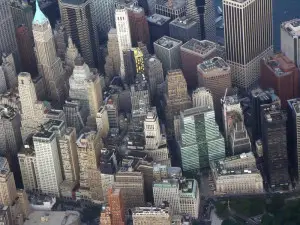
Lower Manhattan is the southern part of the main Island of Manhattan, and it is Downtown Manhattan or the business and government center of New York City. Downtown Manhattan is outlined by 14th Street on the north, the Hudson River on the west, the East River on the east, and New York Harbor on the south. The importance of Downtown Manhattan can be realized by the fact that New York City is the financial capital of the world, and it is home to the largest stock exchange in the world, the New York Stock Exchange. The lower Manhattan business district is the core of the area below Chambers Street. It includes the famous Wall Street and the former site of the World Trade Center.
2. Hagerstown, Maryland
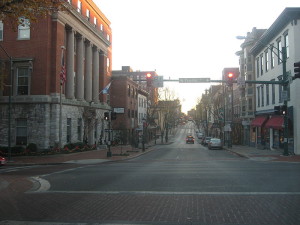
Hagerstown, nicknamed ‘Hub City’ or ‘Maryland’s Gateway to the West,’ according to its motto is a great place to live, work, and visit. Hagerstown is the biggest city in Western Maryland and the sixth biggest city in Maryland. The old buildings are made of Stonehenge limestone, which was easily quarried on site. It whitens with aging, showing beautiful, wavy laminae. St. John’s Episcopal Church and Presbyterian Church are typical examples. Hagerstown is a transit and commerce center. The extensive city transportation network includes; 81, 70, CSX, Norfolk Southern, Winchester, and Western Railroads, and Hagerstown Regional Airport. Hagerstown is the industrial hub for South Central Pennsylvania, Western Maryland, and West Virginia. On this account it is nicknamed Hub City.
3. Chicago Loop
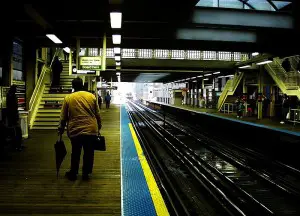
The Chicago Loop is one of the 77 officially designated community areas situated in the city of Chicago, Illinois, U.S. It is the core of Downtown Chicago. It is the government headquarters for Chicago and Cook County. This historic shopping and theatre district includes State Street made famous by Frank Sinatra as ‘that great street.’ The Chicago Loop is bounded on the north and west by the Chicago River, on the east by Lake Michigan, and by Roosevelt Road on the south. The community area includes Grant Park and The Art Institute of Chicago which is one of the largest American museums. Other notable sites are: Chicago Symphony Orchestra, the Lyric Opera of Chicago, The Goodman Theatre, the central public Harold Washington Library, and the Chicago Cultural Center.
4. Downtown Los Angeles
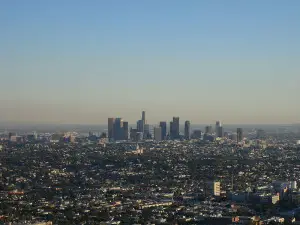
Located in the metropolitan area of Los Angeles, California, Downtown Los Angeles is the central business district. The salient features of Downtown Los Angeles are its arts institutions, sports facilities, a variety of skyscrapers, shopping centers, the city’s freeway network, and the Metro Rapid Transit System. Formerly the downtown area was bounded by the Los Angeles River on the east, the Hollywood Freeway on the north, Santa Monica Freeway to the south, and the Harbor Freeway on the west. The extended area now includes: University Park, Exposition Park, University of Southern California, and Central City West neighborhoods.
5. Financial District, San Francisco
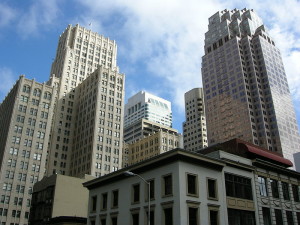
The Financial District, San Francisco, California was at times known as FiDi in the central business district. Its neighborhood was completely destroyed during the 1906 Earthquake and Fire, but its high-rise buildings remained intact miraculously. The area remained a low-rise in the 20th century until 1950 on account of the height restrictions laid down by the government. However, with the development of earthquake retrofitting technology, the trend was reversed to the original now known as ‘Manhattanization’ during the period of Mayor Dianne Feinstein in the 1980s. The district is home to the corporate headquarters of law firms, banks, savings and other financial institutions like VISA, Wells Fargo Bank, and others. Notable skyscrapers of the area include the city’s tallest buildings at: 555 California Street, 101 California Street, and 345 California Street.
6. Downtown Washington, D.C.

Downtown Washington is the neighborhood of Washington, D.C. Formerly it was bounded by Pennsylvania Avenue, New York Avenue, Massachusetts Avenue, and Indiana Avenue. It included Penn Quarter, Mount Vernon Square, Chinatown, and Judiciary Square. With the expansion of the city, it now is considered to include Federal Triangle, Pennsylvania National Historic Site, K Street NW, and DuPont Circle neighborhoods. According to the definition, Downtown Washington extends from P Street NW, south to Constitution Avenue NW, and from 15th Street NW east, to 4th Street NW. The core downtown is mainly comprised of office buildings for commercial use. The downtown area has a comparatively low-rise skyline, and its salient features include: International Spy Museum, National Archives, National Portrait Gallery, Shakespeare Theatre, and Woolly Mammoth Theatre.
7. Downtown Seattle
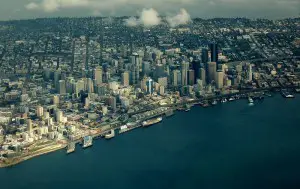
Downtown Seattle is the central business district of Seattle, Washington. Compared with other city centers it is more densely populated. It is marked on the west by Eliot Bay, on the south by reclaimed land of tidal flats, on the north by Denny Way, and on the east by Broadway Avenue. Near the core of the downtown area is Metropolitan Tract. The downtown is Seattle’s main financial center and shopping area surrounding Westlake Center. Other notable buildings include: Washington Mutual Tower, Two Union Square, Nordstrom’s Flagship Store, Benaroya Hall, Seattle Central Library, Rem Koolhaas, and Seattle Art Museum.
8. Downtown Miami
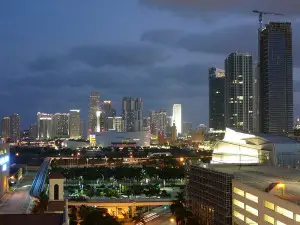
Downtown Miami is the residential neighborhood and central business district of Miami. Brickell Avenue and Biscayne Boulevard are the major northwest roads, and Flagler Street is the main east-west road. Downtown Miami is the commercial, financial, and cultural center of South Florida. With its large-scale high-rise construction and increasing population, Downtown is the fastest growing area in Miami.
9. Downtown New Orleans
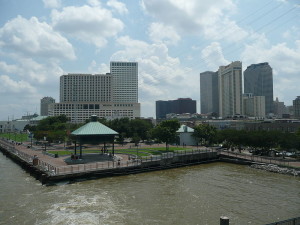
Historically Downtown New Orleans included the neighborhoods along the Mississippi River along with the French Quarter, Treme, Faubourg Marigny, Bywater, and the 9th Ward. With the introduction of the Louisiana legislature, the New Orleans Downtown Development District was defined as a business improvement district bordered by Iberville Street, the Pontchartrain Expressway, Claiborne Avenue, and the Mississippi River. It excludes the French Quarter. Its salient features are: Louisiana Superdome, the New Orleans Arena, the New Orleans Morial Convention Center, Jackson Square, the Riverwalk Marketplace, the Crescent City Connection, and Canal Place.
10. Downtown Philadelphia
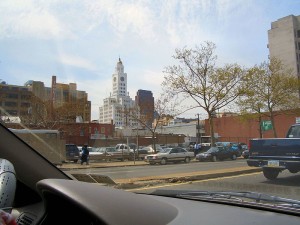
Downtown Philadelphia comprises the central neighborhoods and the central business district of the City of Philadelphia, Pennsylvania, U.S. With a population exceeding 57,000 residents, Philadelphia is considered the third most populous of all downtown areas in the U.S. The city is marked by South Street on the south, the Delaware River on the east, the Schuylkill River on the west, and Vine Street on the North.
Conclusion:
Downtowns have their own specific distinguishing features reflected by their social, commercial, industrial activities and their history as well as their geographical makeup. The geographical center of a downtown represents its culture in the most concentrated form with a diffused periphery mix with similar forms emanating from some other downtown. An aerial view of American downtowns, if it could be visualized in colors, would appear like a beautiful tie-dye design.










Leave a Reply